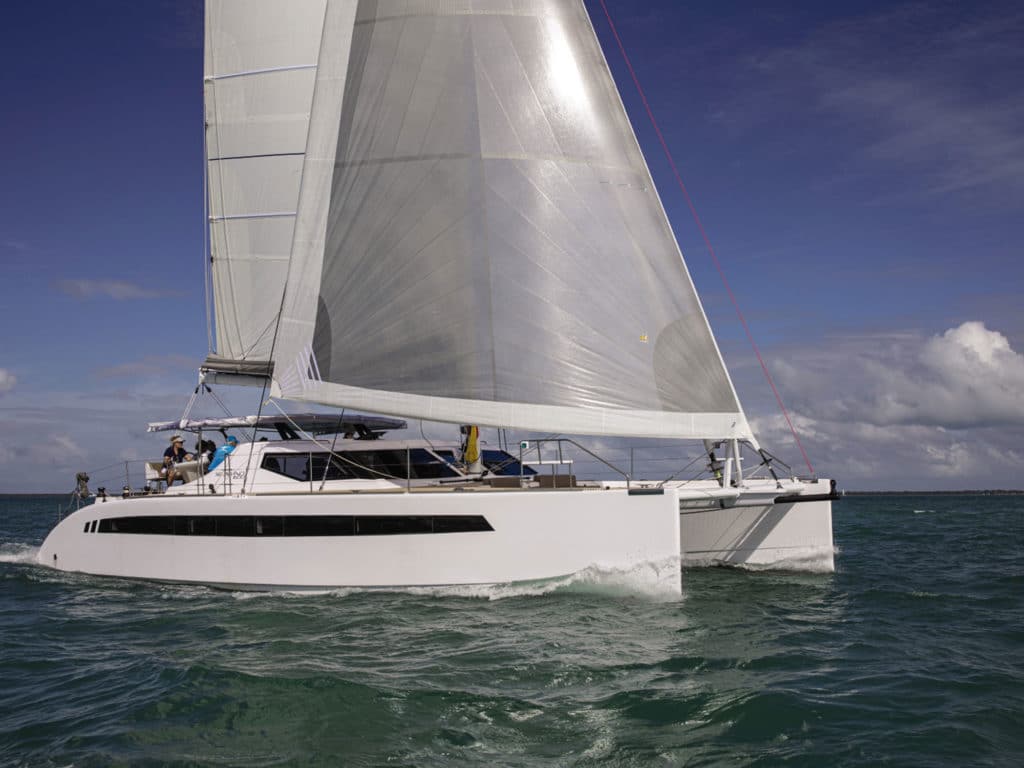
One of the things I like best about baseball is watching a batter swing for the fences, and at the crack of the bat, he knows that he can afford to take a leisurely jog around the bases because he just hit the sweet spot.
I had that same kind of feeling one day this past February when I stepped from the dinghy onto the transom steps of the new Seawind 1600 catamaran. Right away, I knew I was about to go for one fine sail—and on a near-perfect day to boot. Blue sky. Thirteen knots of breeze. Could it get better? Not until the sails were up.
Built in Vietnam, at 52 feet LOA the 1600 is Seawind’s largest catamaran. It was designed by Reichel Pugh as a luxury catamaran with equal measures of cruising comfort and sailing performance. Let’s talk about the sailing first.
The 1600 sports a square-top full-batten main and solent rig with a screecher for light-air reaching and a self-tacking jib for heavier breezes or sailing upwind. There’s an option for an inner forestay and furling storm jib, and also a sprit for flying a spinnaker, which we did on our test sail (more on that in a moment).
Headsail sheets are led to winches adjacent to each helm station. There is no traveler. Instead there are two mainsheets that run through blocks on either side of the stern and then to a central winch on the transom, where reefing lines are also led. This mainsheet arrangement provides lots of control over a big and powerful sail.
On a beam reach with the screecher set, our GPS speed hovered in the high 7-knot range, and when the chute went up, so did our speed, to 8.5 knots and a little higher in any puff we caught. The 1600 uses Lewmar Mamba steering, and the helms felt as smooth as could be. Headed upwind and home, we rolled out the self-tacking jib and still made a respectable 6.6 knots, and thanks to retractable daggerboards, were able to point quite well.
So now, on to the comforts.
The Seawind comes in either a three- or four-cabin layout. On this boat, the owner’s hull was to starboard and included a queen bunk aft, lots of storage, and a spacious head and shower up at the pointy end. The opposite hull had two cabins. The forward one felt a bit narrow because of the fine entry of the bows, but still, it had a double berth and adequate storage space. The aft cabin had two single berths and a filler that turned them into a double. A shared head was amidships.
With windows all around, the saloon was a bright and sunny place to be. Opening ports forward allow a breeze to blow through, and large sliding windows at the aft-facing galley permit the cook to join any party taking place at the large dining table located to starboard out in the cockpit. There’s an indoor table with U-shaped seating as well to port of a forward-facing nav station.
The cockpit is covered by a Bimini that is supported by stainless posts aft and short carbon-fiber risers forward. It provides lots of shade, and the breeze blows through the space between the hard awning and cabin top. This space can be closed off, as can the cockpit sides and back with clear panels. Eight solar panels sit atop the Bimini and keep the battery bank fed (though AGM batteries are standard, the boat we sailed had an optional lithium-ion system).
Furniture throughout the boat is built using a honeycomb foam core and veneers to save weight and for strength. Hulls, deck and Bimini are all cored and infused using vinyl ester resin. An outside layer of Kevlar is added to the hulls for protection and to strengthen the areas around the daggerboards; carbon fiber reinforces the chainplates, bulkheads and stiffeners.
For power, the 1600 comes standard with 57 hp Yanmar diesels; the boat in Miami had a pair of optional 80 hp Yanmars that pushed us along at just over 8 knots at cruising speed and better than 9 in get-home-fast mode. With the larger engines and lots of other options, the 1600 carries a price tag of right around $1.2 million, delivered to the US East Coast. For that, you can enjoy your own sweet spot.
Mark Pillsbury is CW’s editor.








